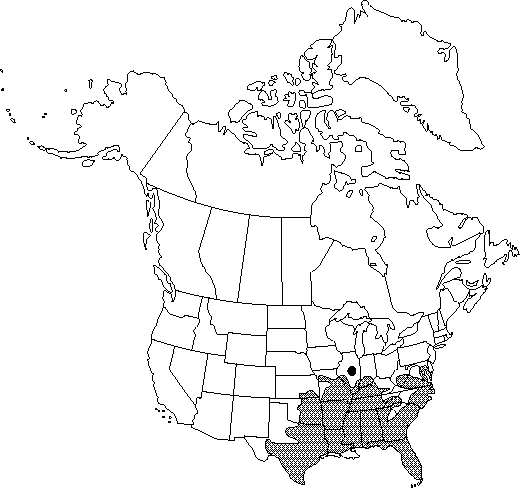Difference between revisions of "Celtis laevigata"
Enum. Pl. suppl: 67. 1814.
FNA>Volume Importer |
FNA>Volume Importer |
||
| Line 39: | Line 39: | ||
}}<!-- | }}<!-- | ||
| − | --><span class="statement" id="st- | + | --><span class="statement" id="st-undefined" data-properties=""><b>Trees,</b> to 30 m; trunks to 1 m diam., crowns broad, spreading. <b>Bark</b> light gray, smooth or covered with corky warts. <b>Branches</b> without thorns, often pendulous, young branches pubescent at first, then glabrous. <b>Leaves</b>: petiole 6-10 mm. <b>Leaf</b> blade typically elliptic-lanceolate to ovate-lanceolate, (4-)6-8(-15) × (2-)3-4 cm, thin and membranaceous to leathery, base broadly cuneate to rounded, margins entire or rarely with a few long teeth, apex sharply acute to acuminate; surfaces glabrous or nearly so, margins ciliate. <b>Inflorescences</b>: flowers solitary or few-flowered clusters at base of leaves. <b>Drupes</b> orange to brown or red when ripe, nearly orbicular, 5-8 mm diam., beakless; pedicel 6-15 mm. <b>Stones</b> 4.5-7 × 5-6 mm. <b>2n</b> = 20, 30, and 40.</span><!-- |
-->{{Treatment/Body | -->{{Treatment/Body | ||
| Line 45: | Line 45: | ||
|habitat=In rich bottomlands along streams, in flood plains, and on rocky slopes | |habitat=In rich bottomlands along streams, in flood plains, and on rocky slopes | ||
|elevation=0-300 m | |elevation=0-300 m | ||
| − | |distribution=Ala.;Ark.;Fla.;Ga.;Ill.;Ind.;Kans.;Ky.;La.;Md.;Miss.;Mo.;N.C.;Okla.;S.C.;Tenn.;Tex.;Va.;W.Va.;n Mexico | + | |distribution=Ala.;Ark.;Fla.;Ga.;Ill.;Ind.;Kans.;Ky.;La.;Md.;Miss.;Mo.;N.C.;Okla.;S.C.;Tenn.;Tex.;Va.;W.Va.;n Mexico. |
|discussion=<p>The Houma used preparations from the bark of Celtis laevigata to treat sore throats and venereal disease (D. E. Moerman 1986).</p> | |discussion=<p>The Houma used preparations from the bark of Celtis laevigata to treat sore throats and venereal disease (D. E. Moerman 1986).</p> | ||
|tables= | |tables= | ||
| Line 65: | Line 65: | ||
|habitat=In rich bottomlands along streams, in flood plains, and on rocky slopes | |habitat=In rich bottomlands along streams, in flood plains, and on rocky slopes | ||
|elevation=0-300 m | |elevation=0-300 m | ||
| − | |distribution=Ala.;Ark.;Fla.;Ga.;Ill.;Ind.;Kans.;Ky.;La.;Md.;Miss.;Mo.;N.C.;Okla.;S.C.;Tenn.;Tex.;Va.;W.Va.;n Mexico | + | |distribution=Ala.;Ark.;Fla.;Ga.;Ill.;Ind.;Kans.;Ky.;La.;Md.;Miss.;Mo.;N.C.;Okla.;S.C.;Tenn.;Tex.;Va.;W.Va.;n Mexico. |
|reference=None | |reference=None | ||
|publication title=Enum. Pl. suppl: | |publication title=Enum. Pl. suppl: | ||
|publication year=1814 | |publication year=1814 | ||
|special status=Selected by author to be illustrated | |special status=Selected by author to be illustrated | ||
| − | |source xml=https://jpend@bitbucket.org/aafc-mbb/fna- | + | |source xml=https://jpend@bitbucket.org/aafc-mbb/fna-data-curation.git/src/9216fc802291cd3df363fd52122300479582ede7/coarse_grained_fna_xml/V3/V3_603.xml |
|genus=Celtis | |genus=Celtis | ||
|species=Celtis laevigata | |species=Celtis laevigata | ||
| − | |||
| − | |||
| − | |||
| − | |||
| − | |||
| − | |||
| − | |||
| − | |||
| − | |||
| − | |||
| − | |||
| − | |||
| − | |||
| − | |||
| − | |||
| − | |||
| − | |||
| − | |||
| − | |||
| − | |||
| − | |||
| − | |||
| − | |||
| − | |||
| − | |||
| − | |||
| − | |||
| − | |||
| − | |||
| − | |||
| − | |||
| − | |||
}}<!-- | }}<!-- | ||
-->[[Category:Treatment]][[Category:Celtis]] | -->[[Category:Treatment]][[Category:Celtis]] | ||
Revision as of 14:44, 27 July 2019
Trees, to 30 m; trunks to 1 m diam., crowns broad, spreading. Bark light gray, smooth or covered with corky warts. Branches without thorns, often pendulous, young branches pubescent at first, then glabrous. Leaves: petiole 6-10 mm. Leaf blade typically elliptic-lanceolate to ovate-lanceolate, (4-)6-8(-15) × (2-)3-4 cm, thin and membranaceous to leathery, base broadly cuneate to rounded, margins entire or rarely with a few long teeth, apex sharply acute to acuminate; surfaces glabrous or nearly so, margins ciliate. Inflorescences: flowers solitary or few-flowered clusters at base of leaves. Drupes orange to brown or red when ripe, nearly orbicular, 5-8 mm diam., beakless; pedicel 6-15 mm. Stones 4.5-7 × 5-6 mm. 2n = 20, 30, and 40.
Phenology: Flowering late spring–early fall (May–Oct).
Habitat: In rich bottomlands along streams, in flood plains, and on rocky slopes
Elevation: 0-300 m
Distribution

Ala., Ark., Fla., Ga., Ill., Ind., Kans., Ky., La., Md., Miss., Mo., N.C., Okla., S.C., Tenn., Tex., Va., W.Va., n Mexico.
Discussion
The Houma used preparations from the bark of Celtis laevigata to treat sore throats and venereal disease (D. E. Moerman 1986).
Selected References
None.
